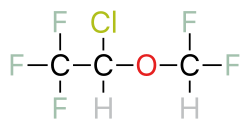A halogenated ether is a subcategory of a larger group of chemicals known as ethers. An ether is an organic chemical that contains an ether group—an oxygen atom connected to two (substituted) alkyl groups. A good example of an ether is the solvent diethyl ether.[1] What differentiates a halogenated ether from other types of ethers is the substitution (halogenation) of one or more hydrogen atoms with a halogen atom. Halogen atoms include fluorine, chlorine, bromine, and iodine.[2]

Use in anesthesiology
editPerhaps the most common use of halogenated ethers has been in anesthesiology.[3] The first widely used inhalation anesthetic was diethyl ether, which is a non-substituted (non-halogenated) ether. This drug enabled surgeons to perform otherwise painful operations on patients after rendering them unconscious.[4]
Diethyl ether has the unfortunate disadvantage of being extremely flammable, especially in the presence of enriched oxygen mixtures.[5] This property has resulted in many instances of fires and even explosions in operating rooms during surgery. Thus, diethyl ether has fallen out of favor as a general anesthetic.[6]
Diethyl ether was initially replaced by non-flammable (but more toxic) halogenated hydrocarbons such as chloroform and trichloroethylene. Halothane is another halogenated hydrocarbon anesthetic agent which was introduced into clinical practice in 1956. Due to its ease of use and improved safety profile with respect to organ toxicity, halothane quickly replaced chloroform and trichloroethylene.
All inhalation anesthetics in current clinical use are halogenated ethers, except for halothane (which is a halogenated hydrocarbon or haloalkane), nitrous oxide, and xenon.[7]
Halogenated ethers have the advantages of being non-flammable as well as less toxic than earlier general anesthetics. Halogenated ethers differ from other ethers because they contain at least one halogen atom in each molecule. Examples of halogenated ethers include the general anesthetics isoflurane, desflurane, and sevoflurane. However, not all halogenated ethers have anesthetic effects, and some compounds such as flurothyl do the opposite and have stimulant and convulsant effects.
Inhalation anesthetics are vaporized and mixed with other gases prior to their inhalation by the patient before or during surgery. These other gases always include oxygen or air, but may also include other gases such as nitrous oxide or helium. In most surgical situations, other drugs such as opiates are used for pain and skeletal muscle relaxants are used to cause temporary paralysis. Additional drugs such as midazolam may be used to produce amnesia during surgery. Although newer intravenous anesthetics (such as propofol) have increased the options of anesthesiologists, halogenated ethers remain a mainstay of general anesthesia.
Use in polymers
editThe perfluorinated epoxides are used as comonomers for the production of polytetrafluoroethylene.[8]
See also
editReferences
edit- ^ Schmitt L, Hinxlage I, Cea PA, Gohlke H, Wesselborg S (February 2021). "40 Years of Research on Polybrominated Diphenyl Ethers (PBDEs)-A Historical Overview and Newest Data of a Promising Anticancer Drug". Molecules. 26 (4): 12. doi:10.3390/molecules26040995. PMC 7918430. PMID 33668501.
- ^ Tang S, Baker GA, Zhao H (May 2012). "Ether- and alcohol-functionalized task-specific ionic liquids: attractive properties and applications". Chemical Society Reviews. 41 (10): 4030–4066. doi:10.1039/c2cs15362a. PMC 3341508. PMID 22456483.
- ^ "Halogenated Anesthetics", LiverTox: Clinical and Research Information on Drug-Induced Liver Injury, Bethesda (MD): National Institute of Diabetes and Digestive and Kidney Diseases, 2012, PMID 31644158, archived from the original on 2022-08-21, retrieved 2022-08-21
- ^ Dunstan M (October 22, 2016). "Ether: The First Anaesthetic – Scientific Scribbles". The University of Melbourne. Retrieved 2022-08-21.
- ^ "Diethyl Ether". webwiser.nlm.nih.gov. National Library of Medicine. Retrieved 2022-08-21.
- ^ Macdonald AG (December 1994). "A brief historical review of non-anaesthetic causes of fires and explosions in the operating room". British Journal of Anaesthesia. 73 (6): 847–856. doi:10.1093/bja/73.6.847. PMID 7880680.
- ^ Luethy A, Boghosian JD, Srikantha R, Cotten JF (June 2017). "Halogenated Ether, Alcohol, and Alkane Anesthetics Activate TASK-3 Tandem Pore Potassium Channels Likely through a Common Mechanism". Molecular Pharmacology. 91 (6): 620–629. doi:10.1124/mol.117.108290. PMC 5438130. PMID 28325748.
- ^ Siegemund, Günter; Schwertfeger, Werner; Feiring, Andrew; Smart, Bruce; Behr, Fred; Vogel, Herward; McKusick, Blaine; Kirsch, Peer (2016-01-28). "Fluorine Compounds, Organic". Ullmann's Encyclopedia of Chemical Technology. Weinheim, Germany: Wiley-VCH Verlag GmbH & Co. KGaA. pp. 1–56. doi:10.1002/14356007.a11_349.pub2. ISBN 978-3-527-30673-2.